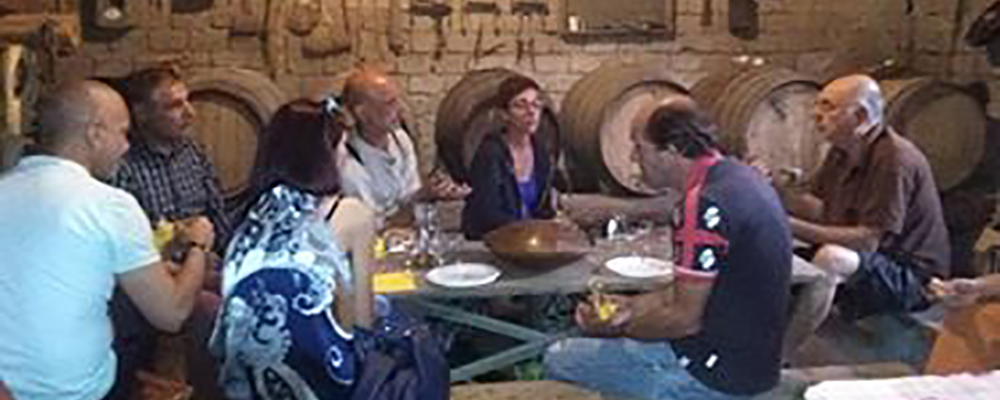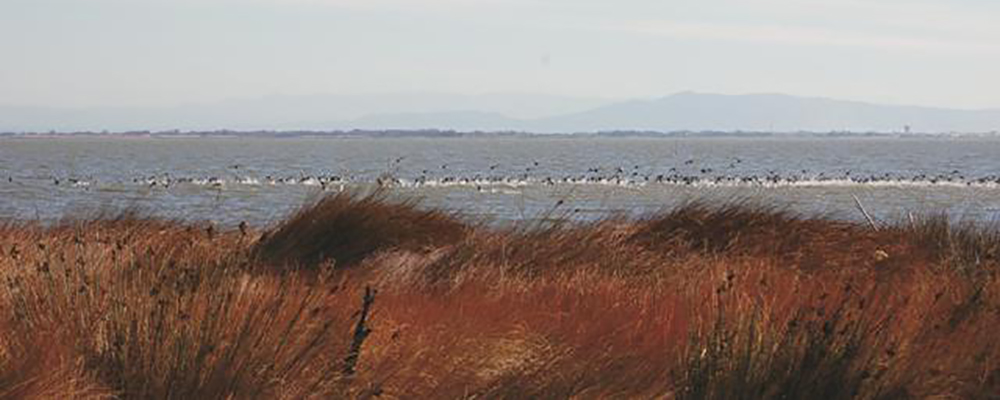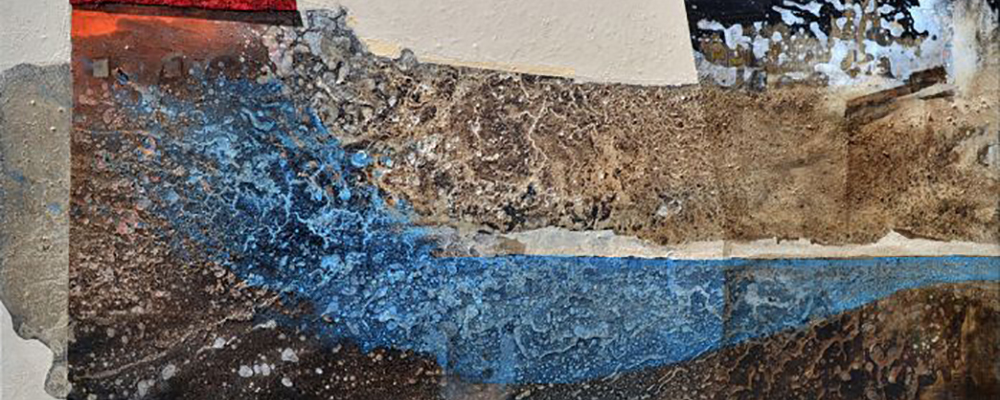In the twilight of the ancient Caddeo winery of Nurachi a small group of Carbonari squares the vernaccia from every side: the fundamental role of chestnut barrels, the peculiar fermentation process and the hectares dedicated to the vineyard, which were five during the 1980s. Now only one remains. And how families preserve for wedding and baptisms the wine that has become amber over the decades, or about the British experts who enthusiastically studied it. It would have a great success in the markets of China and Japan, because of the organoleptic similitudes. But we never understand the potential of our products. There are doubts about the term "murruai" until Tonino Carta, owner of another cellar, arrives to explain: murru in these parts means white. The ending "ai" carries the sense of the old. The white color refers to the almond. Murruai is the ancient almond aroma that envelops the palate. The more the vernaccia is old and valuable the more the murruai persists over time.
Guests begin to flock between the raw bricks and the uneven ground floor, gathering for "Waiting for wines and other stories" the first of a series of events dedicated to the food and wine productions of Nurachi. "For several years the municipality and the Pro Loco have invited me to organize this event. It falls in the period in which anciently the harvest was celebrated, the end of a season and the beginning of the next. Over the centuries, Nurachi has been a crossroads of products between the coast and the interior of this area of Sardinia. This is why producers from other areas also take part in the event, united not only by tradition but by the desire to offer healthy products ”, says Stefano Soi, architect ‘with less and less enthusiasm’ and owner of the “Agricola Soi” wine company, capable to conquer the markets of Denmark, Canada, Germany and England. Indeed, “Waiting for wines” is a return to the land and to healthy and eco-sustainable agriculture. Among the many it will host the bitter-sweet marmalades of Mammai and Dario Torabi, the punk-rock chef specialized in the re-elaboration of poor peasant food. All of them will tell their own story surrounded by the splendid abstract paintings of Marco Pili, the famous Nurachese painter who has made himself known in the world by mixing colors with the land of Sinis, fragments of Carasau bread and old canvases and carpets.
The slow blues of Hola la Poyana floats around the banquet in the Caddeo Cellar, a meeting place and occasional theater for the rousing tunes of a group of Irish tourists, or the "canzonis longasa" performed by a local child, a voice that perpetuates the old anecdotes of village life, recorded with malice in music and rhyme. Nurachi, Tonino Carta had explained before under the walls dotted with ancient, rusted agricultural tools, is no longer "abarrau", immobile, unchanging. It is again the crossroad of the past: "After studying economics abroad and travelling I returned to my grandmto the food and wine productions be refreshed, renewed daily. We too must renew ourselves every day if we want to carry on a centenary history ", says Riccardo Porta, a young entrepreneur who added to the ancient desserts and pasta of the family company the focacce, fluffy sheets to be declined with changing ingredients and toppings to different Sardinian places. The focaccia with ricotta and bottarga is dedicated to the gulf, and accompanied by the Vernaccia "Terre Sinis" from the Cantina del Rimedio in Oristano.
"These gatherings are fundamental to strengthen our identity and at the same time propose a different idea of the future" explains the mayor Renzo Ponti, who speaks and listens to his people inside the cellar or in the short pebbled space of via Nuraghe, low houses from which the bell tower of the seventeenth-century church of San Giovanni Battista emerges, immersed in the clear summer twilight. A few kilometers away lay the pond of Cabras and the Ramsar site of
Mare ‘e Pauli, su fenu (the reed) for the construction of the ancient fishing boats, the fassonis, and the canes for the music of launeddas

The Island made of mussels in Corru Mannu's pond began to be populated by birds
Little tern, common tern, sandwich tern, rosy gull and black-winged stilt are some of the bird species that have found a home in Corru Mannu in recent weeks. Thanks to…

Sardinian Wetlands, the best way to protect them is "to manage them"
Cagliari, 04.02.2023 – Le zone umide sono ecosistemi acquatici sempre più rilevanti, conoscerli meglio è il primo passo per tutelarli, ma non è tutto. “Serve uno strumento di gestione” per…

The II D from Terralba Institute visited the Old Tower of Marceddì as prize for Terre d'Acqua school contest 2022
Learning about the role of these precious and very important ecosystems, as well as the specificities of the large wetland area of Oristano. In recent days we have accompanied the…

Maristanis was showcased at the Ramsar COP 14 on wetlands during a side event
The 14th meeting of the Ramsar Wetlands Conference (COP14) was held in Geneva from 5 to 13 November 2022, simultaneously also in Wuhan, China. At the International Conference Center in Geneva (CICG) all…

Learning from the Maristanis's model in the ENSERES's visit exchange
Two days to study an integrated management model of marine-coastal systems, two days to strengthen ties and develop new strategies for a sustainable future of the Mediterranean. The Italian stage…

A step forward for the Maristanis project, towards the Regional Park of wetlands in Sardinia
The Municipal Council of Oristano, on the proposal of the Councilor for the Environment Maria Bonaria Zedda, has launched the participatory process and the preparatory actions necessary for the establishment…

Evaluating ecosystem services by the TESSA Methodology in Arborea
How to understand the effects on natural capitals and actual and potential state changes of individual sites important in promoting decisions to support both biodiversity conservation and ecosystem service provision?

Terre D'Acqua 2022, the winners of the school contest within the Maristanis Project
With 87 works, of which 84 in the drawing category and 3 in the comics category, the MEDSEA Foundation's Terre D’Acqua 2022 Competition ends. The school contest took place from February…

The Sardinian farms met in Arborea under the sign of Sustainability
This is the year of relaunch for the La Fiera dell’agricoltura di Arborea (Agricultural Fair of Arborea), one of the most important thematic fairs in Sardinia that promotes the productive, agro and…

Maristanis in the news: Rai and Italia 1 dedicated ample space to the Maristanis Project
The Italian press gave ample space to the Maristanis project in recent months, the Oristanese wetlands and its most important project Maristanis were told in various national and local television reports on…

The winner of the World Wetlands Day in Sardinia 2022 Contest
With a picture taken in the Oristanese lagoons representing a group of flamingos and the sentence "They come / They come back / Sometimes they stop / Like nomads /…

Over 700 visitors for the World Wetlands Day Calendar
Over 700 visitors in the World Wetlands Day collective calendar, put together by the MEDSEA Foundation, as part of the Maristanis project last February, with the aim of promoting the precious…

The World Wetlands Day 2022 in Sardinia lasts a month, the events Calendar
As every year, the World Wetlands Day on the anniversary of the RAMSAR convention (of 1971, Feb. 2nd) calls and Sardinia, in particular the Oristanese area, replies within the Maristanis project that…

World Wetlands Day in Sardinia, from 2 to 27 February join the competition #WWDSardegna on Instagram
In the occasion of the World Wetlands Day which celebrates ponds and lagoons in the world next February 2, the MEDSEA foundation launches the contest on wetlands in Sardinia with the hashtag #WWDSardegna to…

MAVA Steering Committee in Provence: Sardinia was promoted with the Maristanis project
MEDSEA foundation, which has been carrying out the Maristanis project in the Oristano area in Sardinia since 2017, attended last week the yearly meeting of the MAVA steering committee. The session took place from 16 to 17 December 2021 in Châteauneuf-le-Rouge, in the Provence-Alpes-Côte d'Azur region, and gathered together the…

Terre d'Acqua, a wetlands school competition for students in the Oristanese
On February 2, the World Wetlands Day will be celebrated once again the Oristanese wetlands region. To recall the central role of wetlands in addressing climate and environmental crisis and to raise awareness of the importance of these basins especially in this west coast side…
- 1
- 2
- 3
- 4



